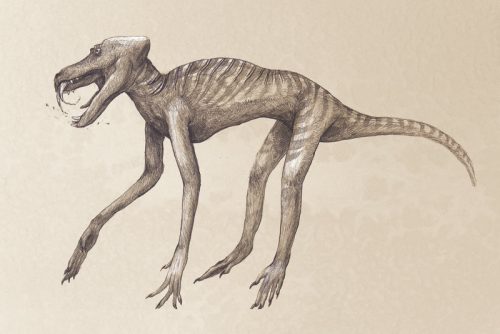They do, and they always have. Here’s an interesting way to illustrate that: make reconstructions of modern animals as if we had no idea about the expected distribution of fat and other soft tissues. Here’s a baboon drawn from its bones while pretending ignorance of hair and lips and such unfossilized stuff:

This is from a book by John Conway, CM Kosemen, and Darren Naish, called All Yesterdays: Unique and Speculative Views of Dinosaurs and Other Prehistoric Animals. I’m going to have to add it to my list.


Apparently I already own this book (on kindle). May have to actually read it.
heh heh heh
assumptions
hehhehheh
BREAKING: Evolutionist Professor Admits Dinosaur Fossils Are Mere Assumptions
The technical term is “shrink-wrapping”. Paleontology has some great technical terms. I also like “thagomizer”, the dangerous-looking spikes or club at the end of the tail in many thyreophorans.
Interesting article on Atlas Obscura, though they do play up the lone revolutionary trope a bit too much. Here’s a good recent discussion from Mark Witton about this very issue:
http://markwitton-com.blogspot.com/2017/08/the-convention-of-shrink-wrapping.html
I knew of this book as I’m a fan of one of the artists involved, C. M. Kosemen A.K.A. nemo-ramjet. I definitely recommend taking a look at his website and DeviantArt gallery.
Looks like something straight out of Bloodborne.
John Conway the mathematician? Good to see he maintains a curious mind.
IMO, “thagomizer” is one of the greatest technical terms, perhaps largely because it was originally a joke in Gary Larson’s The Far Side comic strip.
(The linked-to Ye Pffft! of All Knowledge article implies, despite widespread use, the term hasn’t been formally adopted. I thought it had been?)
Yes, yes, yes. Read this book. The example that sticks out for me is the reconstruction of small protoceratops in a tree. With only fossils to go by, we would never think that goats spend so much time in trees (go ahead and google ‘goats in trees’ I didn’t see anything that wasn’t SFW) and we would never reconstruct them that way. Protoceratops are sheep/goat sized, so why not put them in trees?
Also, if you think the baboon is scary, and they can be scary in real life if provoked, take a look at the cow, http://img.gawkerassets.com/img/1879lx9813lz6jpg/original.jpg, and start humming “Ghost Riders in the Sky.” Or look at the cat and think Halloween: https://i.kinja-img.com/gawker-media/image/upload/s–28_MsCIm–/c_scale,f_auto,fl_progressive,q_80,w_800/1879hkw0ymnkbjpg.jpg
And I always enjoy reading his blog Tetrapod Zoology (Tet Zoo) even if a lot of the details are over my head. https://blogs.scientificamerican.com/tetrapod-zoology/
I do not remember the book, but it had to have been in print in the 1970s. It was a pre-renaissance book, ignoring the more recent (1960s – 70s) research, and was for children. One of the images showed an Iguanodon perched on the branch of a tree, with the toes wrapped around the branch. Given the weight of the animal, that must have been one hell of a tree.
Bogleech did an article about this book a few years ago. Funny thing; one of the examples of real-world blunders was a scholar from 1726 thinking that an extinct salamander was an antideluvian human subspecies.
Ogvorbis@11, I vaguely recall a similar-sounding illustration from the same-ish timeframe. My Generalissimo Google-fu has not located anything.
blf;
Same here. I vaguely remember it as a Scholastic Books publication, sold in the school, in paperback. And it was green.
#9 blf
Ain’t no such thing as “formally adopted”. There is no body in charge of official dinosaur anatomical terms. It’s adopted if people use it. The more people use it, the more adopted. Now as far as I know, it’s been used in only one technical paper so far. Then again, there aren’t all that many technical papers on thyreophoran tails.
John Harshman@15, Yeah, I messed that up, didn’t I! I can’t now recall what I was thinking of when I wrote that, perhaps something like the ICZN convention(? rule?) that the first published species name has priority. Thagomizer is not a species name, so that principle does not (as far as I know) apply.